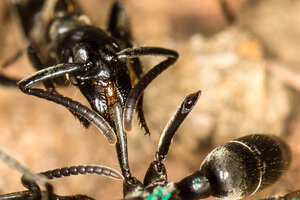Can altruism exist without empathy? Lessons from the ant world
New research shows that termite-hunting Matabele ants dress the wounds of injured comrades. It is the first time an insect has been shown to display healing behavior toward others.

A Matabele ant treats the wounds of a mate whose limbs were bitten off during a fight with termite soldiers. The only other animals that have been observed systematically treating others' injuries are humans and some of our primate relatives.
Courtesy of Erik T. Frank
Named for a famed group of Bantu warriors, the Matabele ant is renowned as a fierce fighter. But the sub-Saharan termite-hunter also shows a caring side.
Researchers have found that Megaponera analis, as scientists call it, will tend to the wounds of nest-mates. The only other animals that have been observed systematically treating others’ injuries are humans and some of our primate relatives.
In other words, ants and humans share what biologists call a convergent trait: caring for another in need. The finding also informs a growing body of research aimed at fitting what we experience as moral sentiments into a larger pattern in nature.
That such precisely directed helping behavior, as it is known, pops up in as distant a relative as the ant belies some popular notions of Darwinian evolution, which characterize natural selection as promoting only selfish behavior. While it’s true that competition both among and within species plays a major role in shaping the evolution of biological traits, it’s not nature’s only driving force.
“I’m a biologist myself, but I’ve always hated the literature from the ’70s and ’80s on selfish genes and a dog-eat-dog world,” says Frans de Waal, a primatologist at Emory University in Atlanta who has written extensively on the evolution of morality among humans and other apes. “That’s a very dominant view.”
That view began to shift in the 1990s, as scientists began looking more closely at cooperative instincts, first in humans. “If you bring people together, the first thing they want to do is cooperate and be nice and harmonious,” says Dr. de Waal, the author of several books on morality and empathy in nonhuman animals. “Now we know from all sorts of studies, including my studies, that actually all of the mammals are a bit like that…. The first tendency is to help.”
Research reveals that a child as young as 14 months will, all else being equal, try to help a stranger correct a mistake, fetch an out-of reach object, or remove an obstacle. This kind of behavior exists in many other mammal species, even when there is no apparent reward: for instance, capuchin monkeys will rescue each other during intergroup battles, rats will free other rats from restrainers, and dolphins will help injured comrades stay afloat for air.
People, being the intelligent, social mammals that we are, like to frame helping in terms of morality. But ants appear to demonstrate “helping behavior without morality,” says Erik Frank, a biologist at the University of Würzburg in Germany who details the phenomenon in a paper published earlier this month in the Proceedings of the Royal Society B.
From an evolutionary point of view, “Morality evolved in us as a mechanism for helping behavior,” he says. “In the ants, it evolved through basic cues.”
When a termite soldier injures a Matabele ant, something that happens frequently during raids on mounds, the wounded ant releases a “help” pheromone that triggers ants nearby to come to her aid.
Injured ants are carried back to the nest, where other ants then “lick” the site of the injury with their mouth appendages, helping to ward off infection. Dr. Frank and his colleagues found that without treatment, 80 percent of injured ants died within 24 hours. Of those that received treatment, only 10 percent died.
“What’s interesting is how very simple rules and very simple cues can lead to these very complex behaviors in ants and in social insects in general,” says Frank.
Human beings do it differently. Instead of being obliged by pheromones, we are motivated by empathy, the ability to quickly and automatically represent in our own minds the mental state of another person. Evolutionary theorists see the emergence of empathy in humans and other animals as biology’s way of promoting altruism.
“We actually think that empathy in mammals started with maternal care,” says de Waal. But, he says “the whole system got co-opted in other relationships because obviously in our societies the mother-child relationship is not the only one we have.
“Empathy got extended, so to speak,” say de Waal.
De Waal points out that cleaning another’s injuries is a common practice among primates, and that the hormonal mechanisms that scientists associate with empathy in humans can be found in a variety of mammals, from chimps to prairie voles. Altruism, whether guided by principle or triggered by instinct, is even more widespread in nature appearing in organisms as diverse as Seychelles warblers to cellular slime molds.
That said, altruism is not always the same thing as pure selflessness. “This type of helping behavior could not have evolved – also our human one – if it wouldn’t have also benefited the actual helper,” says Frank. “No matter how indirect it might be.”

